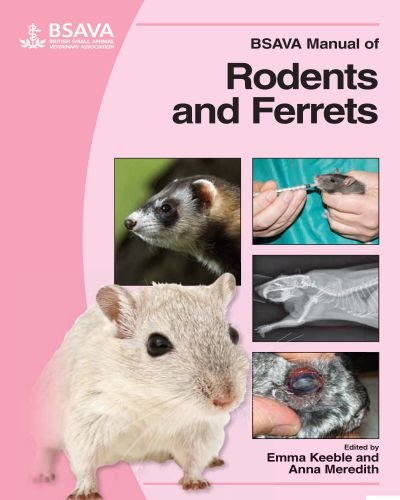Manual of Rodents and Ferrets PDF
In recent years the number of rodents and ferrets kept as pets has grown considerably, with a consequent growth in demand for appropriate veterinary care. Many owners of pet rodents and ferrets develop a strong emotional attachment to their pets and expect high-quality medical care from the veterinary surgeon. For veterinarians, the small size, susceptibility to stress-related problems and short natural life expectancy of these species present challenges compared with traditional companion animals.

Much of the veterinary information available for rodents and ferrets is based on laboratory animal medicine and consequently there is a lack of up-to-date reference texts on medicine and surgery of pet rodents and ferrets. The practitioner needs to have an accessible book that provides information about the biology, husbandry, clinical approach and main disease conditions likely to be encountered in these species. This new BSAVA Manual provides just this, covering the medicine and surgery of rodents and ferrets in much greater depth and breadth than any existing BSAVA publication, in a manner that is easy to read, assimilate and apply to the clinical situation.
The Manual of Rodents and Ferrets PDF covers the most commonly encountered rodent species – mice, rats, hamsters, gerbils, guinea pigs, chinchillas and degus – in detail, as well as containing a separate chapter on the less commonly owned rodent species. In recognition of the very fundamental differences between the rodent group of species and ferrets, the book is presented in two distinct sections. Download: Veterinary Clinical Skills Manual 1st Edition
The first section is devoted to rodents and is divided into two parts. The first part covers biology, husbandry and clinical techniques in rodents (including anaesthesia and surgery, as well as the more unusual rodent species). The second part contains chapters based on common diseases of pet rodents by clinical system. These describe aetiology, clinical signs, diagnosis, treatment and prevention/management where relevant.
The second section focuses on ferrets and is again divided into two parts following the same format as those for the rodent section, including a separate chapter on systemic viral diseases of ferrets. The final part of the book contains a useful appendix on differential diagnoses based on clinical signs in rodents, and in ferrets.
It is well illustrated with many high-quality colour images and contains numerous quick-reference tables, as well as detailed well referenced text. The Manual is aimed at veterinarians, veterinary students and veterinary nurses in practice worldwide as a general reference, but is also useful for those individuals wanting to study this field in greater depth.
Direct Link For Paid Membership: –
